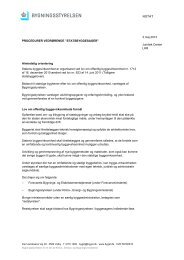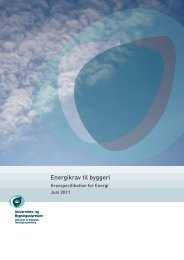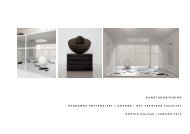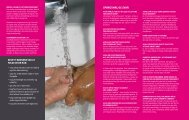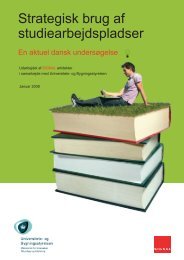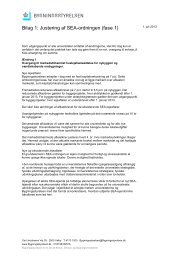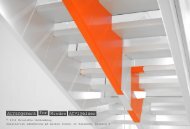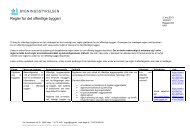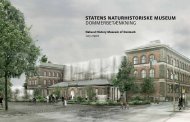Campus og studiemiljø - Bygningsstyrelsen
Campus og studiemiljø - Bygningsstyrelsen
Campus og studiemiljø - Bygningsstyrelsen
You also want an ePaper? Increase the reach of your titles
YUMPU automatically turns print PDFs into web optimized ePapers that Google loves.
minor significance. Instead, the possibility of renting out to others<br />
and thereby creating a profit is of primary significance.<br />
Danish universities are subject to a rent scheme, which implies<br />
that governmental institutions within e.g. the research and teaching<br />
field pay rent for the buildings they use, most of which are let by the<br />
Danish University and Property Agency. This gives the universities<br />
flexibility, as they can terminate a lease at short notice, if they do not<br />
need it or require it for expansion.<br />
Aarhus University additionally collaborates with a property company<br />
under the auspices of the Aarhus University Research Foundation.<br />
The company constructs buildings and then lets them out,<br />
primarily to the university. The property company has been an<br />
active player in the extension of computer scientific learning and<br />
research environments at the Katrinebjerg area, which were bought<br />
and developed by the company. The property company lets out areas<br />
to both businesses and Aarhus University. Consequently, several<br />
subjects within the institute of computer science today coexist side<br />
by side with private consultancies from the IT sector.<br />
When it comes to being able to act quickly to changing area and<br />
functional needs on campus, the challenge is an increased risk and<br />
financial uncertainty. For instance, it may be difficult for universities<br />
to be bound to an area which they are not sure that they will be able<br />
to let out, e.g. to small newly started businesses. The physical presence<br />
creates synergy and is decisive when a university expands. It<br />
may mean increased focus on the existence of e.g. cheap and flexible<br />
areas with low operating costs.<br />
strategic use of accommodation for foreign visitors<br />
The modern university not only offers attractive learning and<br />
research environments, but also attractive accommodation options<br />
for its foreign visitors. The studies indicate that several universities,<br />
also Danish ones, consider the number of foreign visitors on campus<br />
as directly proportional to the number of attractive residences for<br />
foreign researchers and students. The residences are a significant key<br />
in a strategic effort to establish an international study and research<br />
environment. Residences also ensure life on campus and are therefore<br />
included as an urban development factor for the campus.<br />
Foreign universities work with residences on campus to a much<br />
higher degree than Danish universities. American and Anglo-Saxon<br />
universities in particular consider housing options along with the<br />
educational pr<strong>og</strong>ramme, but universities from the European mainland<br />
are also interested in integrating housing on or around campus.<br />
There are historical and cultural reasons why Danish/European<br />
students and researchers primarily live outside campus, as Wilhelm<br />
and Elbe describe in their article. A typical Danish campus<br />
– in contrast to an American – is built as a place of work, and it is<br />
situated as a supplement to the city, just as business areas are. This<br />
explains why housing, shopping facilities and varied cultural spare<br />
time offers for young people are not a natural feature around campus<br />
as it is seen in the USA. In Denmark, we also have a cultural<br />
desire to make young people independent, including by giving<br />
strategi / strategy<br />
them a life where they are physically away from studies and teaching.<br />
Similarly, it is traditional that researchers and teachers do not<br />
spend their spare time at the university, but instead participate in<br />
social life and make use of the cultural offers outside the university.<br />
In spite of these fundamental differences it is, however, worth<br />
noticing a couple of housing initiatives abroad, as the ideas can be<br />
transferred to e.g. accommodation for foreign students or visiting<br />
researchers in Denmark.<br />
Many American universities such as MIT, where 40 % of the undergraduate<br />
students are foreigners, deliberately attempt to make<br />
student life merge with private life. This is done, for instance, by integrating<br />
learning and group rooms at the residence halls, which are<br />
also used for teaching. This is a structure known in Denmark from<br />
the folk high schools, where learning and spare time also merge.<br />
MIT considers housing a good way of ensuring quick integration,<br />
which is particularly important to a researcher or student who is<br />
only visiting for a short time.<br />
MIT also deliberately locates attractive researcher family accommodation<br />
in buildings where students live, in order to further contact in<br />
that way. This is supported by activities such as offers about communal<br />
eating. In practice, this means that the researcher and his/<br />
her family feel at home among the students, and that discussions<br />
continue after class in a more private setting. MIT has experienced<br />
better and quicker integration between visiting researchers and students<br />
as a result of the researcher being accommodated at residence<br />
halls on campus.<br />
ETH Zürich is planning to construct a number of four-room housing<br />
options on campus, because they would like to have an attractive<br />
offer for students and foreign researchers with a family. They are<br />
financed by sponsors and will be rented out via a property company.<br />
The accommodation is deliberately designed as four-room units<br />
so that they can be used either for flat sharing with three to four<br />
students or as spacious researcher family units. This will also make<br />
them attractive to ordinary families, so that in times of recession the<br />
units might be let out to interested parties in the area.<br />
In Denmark, a number of new, attractive foundation-funded student<br />
hostels have been built in Copenhagen, including the Bikuben<br />
and the Tietgen on the University of Copenhagen’s South <strong>Campus</strong><br />
in the Ørestaden district. The offer here is attractive independent<br />
accommodation for young people, with the chance of interacting<br />
with peers. The interest in these housing units seems to be growing<br />
among students, and this probably means that this type of network<br />
accommodation, where you benefit from the resources of each other,<br />
is generally gaining popularity among Danish youth. However, these<br />
student hostels are built by donors without the involvement of the<br />
university or anybody else.<br />
One of the challenges when offering accommodation to foreign visitors<br />
is to clarify who owns and runs the residences. In Denmark, the<br />
municipalities are generally under obligation to provide housing,<br />
43





